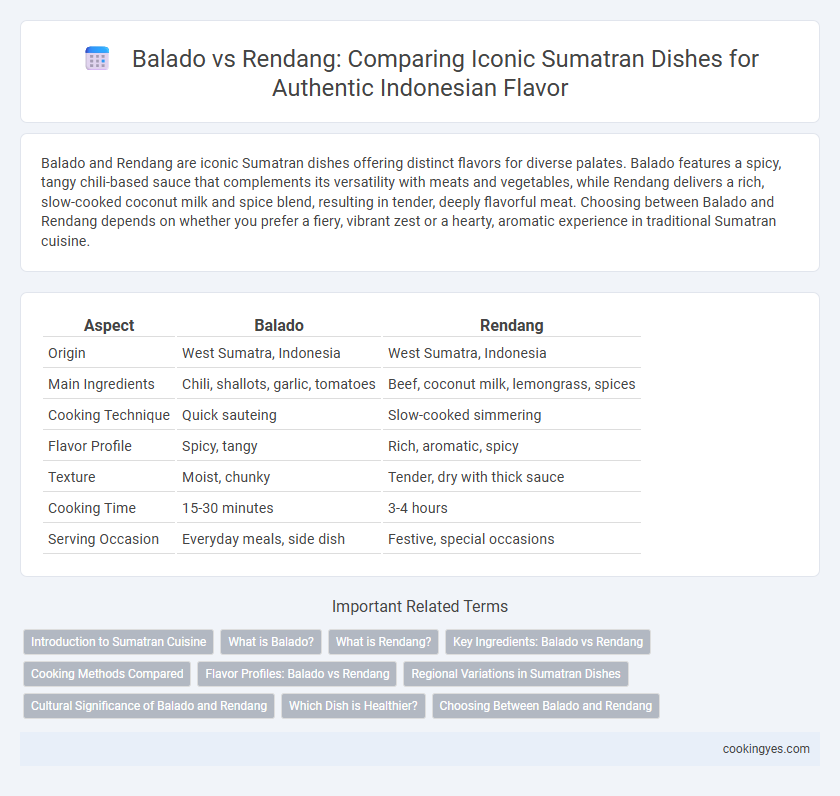Balado and Rendang are iconic Sumatran dishes offering distinct flavors for diverse palates. Balado features a spicy, tangy chili-based sauce that complements its versatility with meats and vegetables, while Rendang delivers a rich, slow-cooked coconut milk and spice blend, resulting in tender, deeply flavorful meat. Choosing between Balado and Rendang depends on whether you prefer a fiery, vibrant zest or a hearty, aromatic experience in traditional Sumatran cuisine.
Table of Comparison
| Aspect | Balado | Rendang |
|---|---|---|
| Origin | West Sumatra, Indonesia | West Sumatra, Indonesia |
| Main Ingredients | Chili, shallots, garlic, tomatoes | Beef, coconut milk, lemongrass, spices |
| Cooking Technique | Quick sauteing | Slow-cooked simmering |
| Flavor Profile | Spicy, tangy | Rich, aromatic, spicy |
| Texture | Moist, chunky | Tender, dry with thick sauce |
| Cooking Time | 15-30 minutes | 3-4 hours |
| Serving Occasion | Everyday meals, side dish | Festive, special occasions |
Introduction to Sumatran Cuisine
Sumatran cuisine is renowned for its rich, bold flavors and diverse use of spices, with rendang and balado standing out as iconic dishes. Rendang, a slow-cooked dry curry made from beef simmered in coconut milk and a complex blend of spices, embodies the depth of Minangkabau culinary tradition. Balado offers a fiery chili-based sauce that complements various ingredients, showcasing the vibrant and spicy character distinctive to Sumatran cooking.
What is Balado?
Balado is a spicy Indonesian chili-based sauce originating from West Sumatra, characterized by its vibrant red color and the use of ground red chilies, shallots, garlic, and tomatoes. Commonly served as a condiment or stir-fried with ingredients such as eggs, potatoes, or seafood, Balado offers a fiery, tangy flavor profile distinct from the rich, slow-cooked coconut and spice blend of Rendang. Unlike Rendang's complex cooking process and tender meat texture, Balado provides a quicker, zestier alternative that complements a variety of Sumatran dishes.
What is Rendang?
Rendang is a rich and savory Indonesian dish originating from West Sumatra, made by slow-cooking beef in coconut milk and a complex blend of spices such as lemongrass, galangal, garlic, and chili until the liquid evaporates and the meat becomes tender and infused with deep flavor. Unlike Balado, which is a spicy chili-based sauce often used as a condiment or topping, Rendang is a dry curry with a thick, caramelized texture and intensely aromatic profile. Rendang exemplifies Minangkabau culinary heritage with its unique cooking method that preserves the dish while developing its characteristic taste.
Key Ingredients: Balado vs Rendang
Balado features a spicy chili-based sambal made from red chilies, shallots, garlic, and kaffir lime leaves, giving it a bright and fiery flavor often used for vegetables and seafood. Rendang relies on a rich, slow-cooked coconut milk and spice mixture including lemongrass, ginger, turmeric, galangal, and toasted coconut, creating tender beef infused with deep, complex aromas. The key ingredient difference lies in Balado's fresh chili paste versus Rendang's creamy, spiced coconut milk base, defining their distinct Sumatran culinary profiles.
Cooking Methods Compared
Balado and Rendang, both iconic Sumatran dishes, differ significantly in cooking methods that impact their flavors and textures. Balado involves quick sauteing of ingredients like chili, shallots, and garlic, creating a vibrant, spicy coating typically served immediately or with minimal simmering. In contrast, Rendang requires slow-cooking beef in coconut milk and a complex spice blend for several hours, resulting in tender meat infused with rich, caramelized flavors and dry, thick sauce.
Flavor Profiles: Balado vs Rendang
Balado features a vibrant, spicy flavor built from red chili peppers, garlic, shallots, and tomatoes, resulting in a tangy and fiery taste that complements its crisp texture. Rendang offers a rich, complex profile with slow-cooked beef infused with coconut milk, lemongrass, galangal, and a blend of indigenous spices, producing a deep, savory, and slightly sweet intensity. The contrasting flavor profiles highlight Balado's sharp heat and freshness against Rendang's hearty, aromatic umami, showcasing the diverse culinary heritage of Sumatra.
Regional Variations in Sumatran Dishes
Balado and Rendang highlight distinctive regional variations within Sumatran cuisine, with Balado featuring a fiery chili-based sauce typical of West Sumatra's Padang region, while Rendang is a slow-cooked, rich coconut milk and spice-infused beef dish originating from the Minangkabau ethnic group. Balado emphasizes bold, sharp flavors with ingredients like bird's eye chili and tomato, contrasting Rendang's complex, mellow taste developed through hours of simmering. These dishes showcase Sumatra's diverse culinary landscape, reflecting local ingredients, cooking techniques, and cultural influences unique to their respective areas.
Cultural Significance of Balado and Rendang
Balado and Rendang hold profound cultural significance within Sumatran cuisine, exemplifying the rich culinary heritage of the region. Rendang, a slow-cooked dry curry originating from the Minangkabau ethnic group, symbolizes communal celebration and spiritual rituals, reflecting its deep-rooted association with tradition and identity. Balado, a spicy chili-based condiment from West Sumatra, represents everyday culinary expression and adaptability, showcasing the region's vibrant palate and social bonding through shared meals.
Which Dish is Healthier?
Balado and Rendang are popular Sumatran dishes, but Balado is generally healthier due to its lower fat content and simpler cooking method. Rendang, slow-cooked in coconut milk and spices, contains higher saturated fat and calories. Balado features a spicy chili-based sauce often made with fresh vegetables, making it a lighter option rich in antioxidants and vitamins.
Choosing Between Balado and Rendang
Balado and Rendang are iconic Sumatran dishes distinguished by their flavor profiles and cooking techniques; Balado features a spicy chili-based sauce that is quicker to prepare, while Rendang involves slow-cooking beef in rich coconut milk and spices until tender, offering deeper, complex flavors. Choosing between Balado and Rendang depends on preferences for texture and intensity--Balado provides a fresh, fiery kick suitable for lighter meals, whereas Rendang delivers a hearty, savory experience ideal for special occasions. Both dishes highlight the distinctive culinary heritage of Sumatra, emphasizing bold spices and regional ingredients like chili, turmeric, galangal, and coconut.
Balado vs Rendang for Sumatran dishes Infographic

 cookingyes.com
cookingyes.com